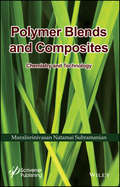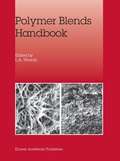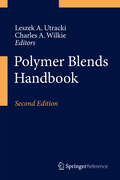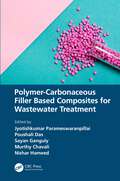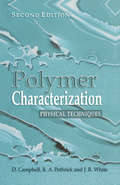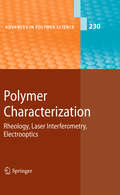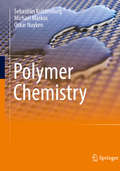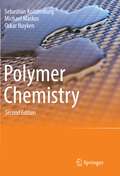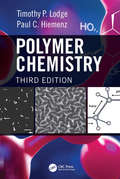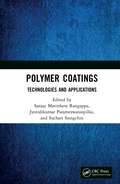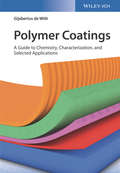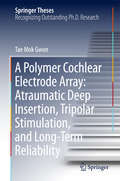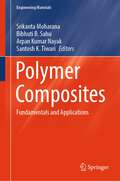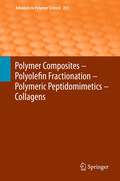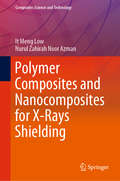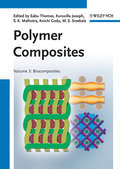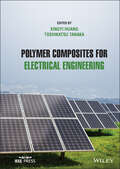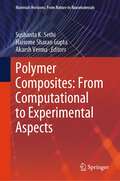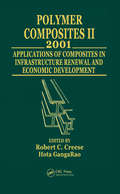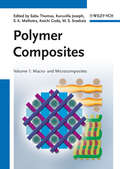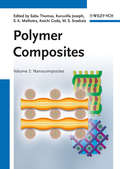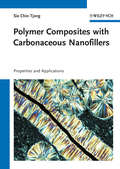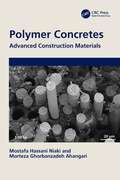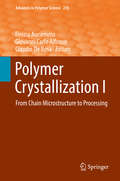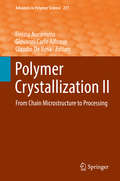- Table View
- List View
Polymer Blends and Composites: Chemistry and Technology
by Muralisrinivasan Natamai SubramanianBecause it is critically important to manufacture quality products, a reasonable balance must be drawn between control requirements and parameters for improved processing method with respect to plastics additives. An important contribution to the commercial polymer industry, Polymer Blends and Composites is one of the first books to combine plastics additives, testing, and quality control. The book is a comprehensive treatise on properties that provides detailed guidelines for selecting and using blends and composites for applications. A valuable resource for operators, processors, engineers, chemists, the book serves to stimulate those already active in natural polymer composites.
Polymer Blends Handbook
by L. A. UtrackiThis unique handbook is a fundamental reference on polymer blends, covering all aspects: science, engineering, technology, and application. The editor has put together an international group of highly respected contributors to create an exceptional source of information invaluable for anyone blending polymers.
Polymer Blends Handbook
by Leszek A. Utracki Charles A. WilkieThe Polymer Blends Handbook is a fundamental reference work on polymer blends, covering all aspects: science, engineering, technology and application. It will appeal to anyone working in the field of blends, researchers as well as engineers. The Handbook is designed to be the source of information on all aspects of polymer blends. To this end the Editors have put together an international group of highly respected contributors, each an expert in his chosen subjects.
Polymer-Carbonaceous Filler Based Composites for Wastewater Treatment
by Jyotishkumar Parameswaranpillai Poushali Das Sayan Ganguly Murthy Chavali Nishar HameedPolymer-Carbonaceous Filler Based Composites for Wastewater Treatment serves as the first book to offer a concise treatment of the use of these materials in the treatment of wastewater. It provides a systematic and comprehensive account of recent developments and encompasses novel methods for the synthesis of carbonaceous derivatives-based fillers for polymer composites, their characterization techniques, and applications for the remediation of water contamination. This book seeks to: Introduce novel concepts in wastewater treatment with poly-carbonaceous composites Describe modern fabrication methods and characterization techniques Present information on processing, safety, and disposal Discuss current research, future trends, and applications Filling the void for a one-stop reference book for researchers, this work includes contributions from leaders in the industry, academia, government, and private research institutions across the globe. Academics, researchers, scientists, engineers, and students in the fields of materials and polymer engineering and wastewater treatment will benefit from this application-oriented book.
Polymer Characterization: Physical Techniques, 2nd Edition
by Dan Campbell Richard A. Pethrick Jim R. WhiteDiscerning the properties of polymers and polymer-based materials requires a good understanding of characterization. This revised and updated text provides a comprehensive survey of characterization methods within its simple, concise chapters. Polymer Characterization: Physical Techniques, provides an overview of a wide variety of characterization methods, which makes it an excellent textbook and reference. It starts with a description of basic polymer science, providing a solid foundation from which to understand the key physical characterization techniques. The authors explain physical principles without heavy theory and give special emphasis to the application of the techniques to polymers, with plenty of illustrations. Topics covered include molecular weight determination, molecular and structural characterization by spectroscopic techniques, morphology and structural characterization by microscopy and diffraction, and thermal analysis. This edition contains a new chapter on surface analysis as well as some revised problems and solutions. The concise treatment of each topic offers even those with little prior knowledge of the subject an accessible source to relevant, simple descriptions in a well-organized format.
Polymer Characterization
by Jean-François Joanny Karel Dusˇek-Shear-Induced Transitions and Instabilities in Surfactant Wormlike Micelles By S. Lerouge, J.-F. Berret -Laser-Interferometric Creep Rate Spectroscopy of Polymers By V. A. Bershtein, P. N. Yakushev -Polymer Nanocomposites for Electro-Optics: Perspectives on Processing Technologies, Material Characterization, and Future Application K. Matras-Postolek, D. Bogdal
Polymer Chemistry
by Sebastian Koltzenburg Michael Maskos Oskar NuykenThis comprehensive textbook describes the synthesis, characterization and technical and engineering applications of polymers. Offering a broad and balanced introduction to the basic concepts of macromolecular chemistry and to the synthesis and physical chemistry of polymers, it is the ideal text for graduate students and advanced Masters students starting out in polymer science. Building on the basic principles of organic chemistry and thermodynamics, it provides an easily understandable and highly accessible introduction to the topic. Step by step, readers will obtain a detailed and well-founded understanding of this vibrant and increasingly important subject area at the intersection between chemistry, physics, engineering and the life sciences. Following a different approach than many other textbooks in the field, the authors, with their varying backgrounds (both from academia and industry), offer a new perspective. Starting with a clear and didactic introduction, the book discusses basic terms and sizes and shapes of polymers and macromolecules. There then follows chapters dedicated to polymers in solutions, molar mass determination, and polymers in the solid state, incl. (partially) crystalline or amorphous polymers as well as their application as engineering materials. Based on this information, the authors explain the most important polymerization methods and techniques. Often neglected in other textbooks, there are chapters on technical polymers, functional polymers, elastomers and liquid crystalline polymers, as well as polymers and the environment. An overview of current trends serves to generate further interest in present and future developments in the field. This book is the English translation of the successful German textbook "Polymere", which was awarded the Chemical Industry in Germany's 2015 literature Prize ("Literaturpreis des Fonds der Chemischen Industrie") for its innovative, novel approach, and its good accessibility and readability, while at the same time providing comprehensive coverage of the field of polymer science.
Polymer Chemistry
by Sebastian Koltzenburg Michael Maskos Oskar NuykenAwarded the Literature Prize of the VCI This comprehensive textbook describes the synthesis, characterization and technical and engineering applications of polymers. Polymers are unique molecules and have properties different from any other class of materials. We encounter them in everyday life, not only in the form of the well-known, large-volume plastics such as PE or PP or the many other special polymers, some of which are very specifically modified but also in nature as polymeric biomolecules, such as DNA. Our life, as we know it, would not only be completely different without macromolecules but it would also be biologically impossible. This textbook provides a broad knowledge of the basic concepts of macromolecular chemistry and the unique properties of this class of materials. Environmentally relevant topics, such as biopolymers and microplastic, which should not be missing in a contemporary textbook are also covered. Building on basic knowledge of organic chemistry and thermodynamics, the book presents an easy-to-understand yet in-depth picture of this very dynamic and increasingly important interdisciplinary science that involves elements of chemistry, physics, engineering, and the life sciences. Readers of this work can confirm their understanding of the text at the end of each chapter by working through a selection of exercises. In writing the book, great importance was attached to good readability despite the necessary depth of detail. It is a book that is just as suitable for students of chemistry and related courses as it is for the applied scientist in an industrial environment. The first edition of this work is so far the only textbook on polymer chemistry to be awarded the Literature Prize of the Fund of the German Chemical Industry Association in 2015.
Polymer Chemistry: The Basic Concepts
by Timothy P. LodgeA well-rounded and articulate examination of polymer properties at the molecular level, Polymer Chemistry focuses on fundamental principles based on underlying chemical structures, polymer synthesis, characterization, and properties. It emphasizes the logical progression of concepts and provide mathematical tools as needed as well as fully derived problems for advanced calculations. The much-anticipated Third Edition expands and reorganizes material to better develop polymer chemistry concepts and update the remaining chapters. New examples and problems are also featured throughout. This revised edition: Integrates concepts from physics, biology, materials science, chemical engineering, and statistics as needed. Contains mathematical tools and step-by-step derivations for example problems. Incorporates new theories and experiments using the latest tools and instrumentation and topics that appear prominently in current polymer science journals. Polymer Chemistry, Third Edition offers a logical presentation of topics that can be scaled to meet the needs of introductory as well as more advanced courses in chemistry, materials science, polymer science, and chemical engineering.
Polymer Coatings: Technologies And Applications
by Sanjay Mavinkere Rangappa Jyotishkumar Parameswaranpillai Suchart SiengchinPolymer Coatings: Technologies and Applications provides a comprehensive account of the recent developments in polymer coatings encompassing novel methods, techniques, and a broad spectrum of applications. The chapters explore the key aspects of polymer coatings while highlighting fundamental research, different types of polymer coatings, and technology advances. This book also integrates the various aspects of these materials from synthesis to application. Current status, trends, future directions, and opportunities are also discussed. FEATURES Examines the basics to the most recent advances in all areas of polymer coatings Serves as a one-stop reference Discusses polymer-coated nanocrystals and coatings based on nanocomposites Describes morphology, spectroscopic analysis, adhesion, and rheology of polymer coatings Explores conducting, stimuli-responsive, self-healing, hydrophobic and hydrophilic, antifouling, and antibacterial polymer coatings Covers modeling and simulation With contributions from the top international researchers from industry, academia, government, and private research institutions, both new and experienced readers will benefit from this applications-oriented book. Sanjay Mavinkere Rangappa is a research scientist at the Natural Composites Research Group Lab, Academic Enhancement Department, King Mongkut’s University of Technology North Bangkok, Thailand. Jyotishkumar Parameswaranpillai is a research professor at the Center of Innovation in Design and Engineering for Manufacturing, King Mongkut’s University of Technology North Bangkok, Thailand. Suchart Siengchin is a professor at and president of King Mongkut’s University of Technology North Bangkok, Thailand.
Polymer Coatings: A Guide to Chemistry, Characterization, and Selected Application
by Gijsbertus De WithA practical guide to polymer coatings that covers all aspects from materials to applications Polymer Coatings is a practical resource that offers an overview of the fundamentals to the synthesis, characterization, deposition methods, and recent developments of polymer coatings. The text includes information about the different polymers and polymer networks in use, resins for solvent- and water-based coatings, and a variety of additives. It presents deposition methods that encompass frequently used mechanical and electrochemical approaches, in addition to the physical-chemical aspects of the coating process. The author covers the available characterization methods including spectroscopic, morphological, thermal and mechanical techniques. The comprehensive text also reviews developments in selected technology areas such as electrically conductive, anti-fouling, and self-replenishing coatings. The author includes insight into the present status of the research field, describes systems currently under investigation, and draws our attention to yet to be explored systems. This important text: • Offers a thorough overview of polymer coatings and their applications • Covers different classes of materials, deposition methods, coating processes, and ways of characterization • Contains a text that is designed to be accessible and helps to apply the acquired knowledge immediately • Includes information on selected areas of research with imminent application potential for functional coatings Written for chemists in industry, materials scientists, polymer chemists, and physical chemists, Polymer Coatings offers a text that contains the information needed to gain an understanding of the charaterization and applications of polymer coatings.
A Polymer Cochlear Electrode Array: Atraumatic Deep Insertion, Tripolar Stimulation, and Long-Term Reliability (Springer Theses)
by Tae Mok GwonThis book describes the design, fabrication and evaluation of a polymer-based neural interface for a cochlear electrode array, reviewed in terms of fabrication process, functionality, and reliability. Polymer-based devices have attracted attention in the neural prosthetic field due to their flexibility and compatibility with micro-fabrication process. A liquid crystal polymer (LCP) is an inert, highly water-resistant polymer suitable for the encapsulation of electronic components and as a substrate material for fabricating neural interfaces. The author has designed, fabricated, and evaluated an LCP-based cochlear electrode array for an improved polymer-based cochlear implant. The thesis deals with 3 key topics: atraumatic deep insertion, tripolar stimulation, and long-term reliability. Atraumatic insertion of the intracochlear electrode and resulting preservation of residual hearing have become essential in state–of-the-art cochlear implantation. A novel tapered design of an LCP-based cochlear electrode array is presented to meet such goals. For high-density and pitch-recognizable cochlear implant, channel interaction should be avoided. Local tripolar stimulation using multi-layered electrode sites are shown to achieve highly focused electrical stimulation. This thesis addresses another vital issue in the polymer-based neural implants: the long-term reliability issue. After suggesting a new method of forming mechanical interlocking to improve polymer-metal adhesion, the author performs accelerating aging tests to verify the method’s efficacy. The aforementioned three topics have been thoroughly examined through various in vitro and in vivo studies. Verification foresees the development of LCP-based cochlear electrode array for an atraumatic deep insertion, advanced stimulation, and long-term clinical implant.
Polymer Composites: Fundamentals and Applications (Engineering Materials)
by Santosh K. Tiwari Srikanta Moharana Bibhuti B. Sahu Arpan Kumar NayakThis book highlights the fundamentals and recent advances for developing novel polymer composites for various applications, including 3D printing, automotive, textiles, agriculture, nanogenerators, energy storage and biomedical engineering. It presents various facile processing techniques to prepare polymeric composites with attractive properties like mechanical strength, flexibility, thermal & electrical performances for end used applications from bench to field. This in-sight of properties, performances and utility will lead to technological applications of polymer composites. It provides a platform for evolving and expanding technological solutions for challenges in the contemporary world, and presents a concrete path for advancement in this domain of polymer composite for professionals, researchers, material scientists, and students.
Polymer Composites – Polyolefin Fractionation – Polymeric Peptidomimetics – Collagens
by Akihiro Abe Hans-Henning Kausch Harald Pasch Martin MöllerTechnology and Development of Self-Reinforced Polymer Composites, by Ben Alcock und Ton Peijs; Recent Advances in High-Temperature Fractionation of Polyolefins, by Harald Pasch, Muhammad Imran Malik und Tibor Macko ; Antibacterial Peptidomimetics: Polymeric Synthetic Mimics of Antimicrobial Peptides, by Karen Lienkamp, Ahmad E. Madkour und Gregory N. Tew; Collagen in Human Tissues: Structure, Function, and Biomedical Implications from a Tissue Engineering Perspective, by Molamma P. Prabhakaran;
Polymer Composites and Nanocomposites for X-Rays Shielding (Composites Science and Technology)
by It Meng Low Nurul Zahirah Noor AzmanThis book focuses on the processing, materials design, characterisation, and properties of polymer composites and nanocomposites for use as electromagnetic radiation shielding materials and to enhance radiation shielding capacity in order to meet the safety requirements for use in medical X-ray imaging facilities. It presents an in-depth analysis of materials synthesis methods such as melt-mixing, ion-implantation, solution casting and electrospinning. In addition, it measures the X-ray attenuation behaviour of fabricated composites and nanocomposites in four major types of X-ray equipment, namely general radiography, mammography, X-ray absorption spectroscopy and X-ray fluorescence spectroscopy units. Given its scope, the book will benefit researchers, engineers, scientists and practitioners in the fields of medical imaging, diagnostic radiology and radiation therapy.
Polymer Composites, Biocomposites
by S. K. Malhotra Kuruvilla Joseph Sabu Thomas Koichi Goda M. S. SreekalaPolymer composites are materials in which the matrix polymer is reinforced with organic/inorganic fillers of a definite size and shape, leading to enhanced performance of the resultant composite. These materials find a wide number of applications in such diverse fields as geotextiles, building, electronics, medical, packaging, and automobiles.This first systematic reference on the topic emphasizes the characteristics and dimension of this reinforcement. The authors are leading researchers in the field from academia, government, industry, as well as private research institutions across the globe, and adopt a practical approach here, covering such aspects as the preparation, characterization, properties and theory of polymer composites.The book begins by discussing the state of the art, new challenges, and opportunities of various polymer composite systems. Interfacial characterization of the composites is discussed in detail, as is the macro- and micromechanics of the composites. Structure-property relationships in various composite systems are explained with the help of theoretical models, while processing techniques for various macro- to nanocomposite systems and the influence of processing parameters on the properties of the composite are reviewed in detail. The characterization of microstructure, elastic, viscoelastic, static and dynamic mechanical, thermal, tribological, rheological, optical, electrical and barrier properties are highlighted, as well as their myriad applications.Divided into three volumes: Vol. 1. Macro- and Microcomposites; Vol. 2. Nanocomposites; and Vol. 3. Biocomposites.
Polymer Composites for Electrical Engineering (IEEE Press)
by Xingyi Huang Toshikatsu TanakaExplore the diverse electrical engineering application of polymer composite materials with this in-depth collection edited by leaders in the field Polymer Composites for Electrical Engineering delivers a comprehensive exploration of the fundamental principles, state-of-the-art research, and future challenges of polymer composites. Written from the perspective of electrical engineering applications, like electrical and thermal energy storage, high temperature applications, fire retardance, power cables, electric stress control, and others, the book covers all major application branches of these widely used materials. Rather than focus on polymer composite materials themselves, the distinguished editors have chosen to collect contributions from industry leaders in the area of real and practical electrical engineering applications of polymer composites. The book's relevance will only increase as advanced polymer composites receive more attention and interest in the area of advanced electronic devices and electric power equipment. Unique amongst its peers, Polymer Composites for Electrical Engineering offers readers a collection of practical and insightful materials that will be of great interest to both academic and industrial audiences. Those resources include: A comprehensive discussion of glass fiber reinforced polymer composites for power equipment, including GIS, bushing, transformers, and more) Explorations of polymer composites for capacitors, outdoor insulation, electric stress control, power cable insulation, electrical and thermal energy storage, and high temperature applications A treatment of semi-conductive polymer composites for power cables In-depth analysis of fire-retardant polymer composites for electrical engineering An examination of polymer composite conductors Perfect for postgraduate students and researchers working in the fields of electrical, electronic, and polymer engineering, Polymer Composites for Electrical Engineering will also earn a place in the libraries of those working in the areas of composite materials, energy science and technology, and nanotechnology.
Polymer Composites: From Computational to Experimental Aspects (Materials Horizons: From Nature to Nanomaterials)
by Sushanta K. Sethi Hariome Sharan Gupta Akarsh VermaThis book is intended to shed light on the computational modeling and experimental techniques that are used in the characterization of various polymer based composite materials. It covers mechanisms, salient features, formulations, important aspects, and case studies of polymer composite materials utilized for various applications. The latest research in this area as well as possible avenues of future research is also highlighted to encourage the researchers.
Polymer Composites II: Composites Applications in Infrastructure Renewal and Economic Development
by Robert C. Creese Hota GangaRaoBased on polymer conferences held in 1999 and 2001, Polymer Composites II: Composites Applications in Infrastructure Renewal and Economic Development is a collection of status reports, success stories, and new opportunities from specific composite applications in infrastructure renewal that provide insight to the resulting economic development and effects. This volume brings together multidisciplinary experts involved with polymer composites who validate their design, construction, and performance and present the role that composites play in infrastructure renewal, detail the technical and regualtory barriers, identify helpful agencies, and estimate the possibilities of economic development.
Polymer Composites, Macro- and Microcomposites: Volume 1: Composites (Green Chemistry Ser. #Volume 16)
by Sabu Thomas Kuruvilla Joseph Sant Kumar Malhotra Koichi Goda Meyyarappallil Sadasivan SreekalaThe first systematic reference on the topic with an emphasis on the characteristics and dimension of the reinforcement. This first of three volumes, authored by leading researchers in the field from academia, government, industry, as well as private research institutions around the globe, focuses on macro and micro composites. Clearly divided into three sections, the first offers an introduction to polymer composites, discussing the state of the art, new challenges, and opportunities of various polymer composite systems, as well as preparation and manufacturing techniques. The second part looks at macro systems, with an emphasis on fiber reinforced polymer composites, textile composites, and polymer hybrid composites. Likewise, the final section deals with micro systems, including micro particle reinforced polymer composites, the synthesis, surface modification and characterization of micro particulate fillers and flakes as well as filled polymer micro composites, plus applications and the recovery, recycling and life cycle analysis of synthetic polymeric composites.
Polymer Composites, Nanocomposites
by Koichi Goda Sabu Thomas S. K. Malhotra Kuruvilla Joseph M. S. SreekalaPolymer composites are materials in which the matrix polymer is reinforced with organic/inorganic fillers of a definite size and shape, leading to enhanced performance of the resultant composite. These materials find a wide number of applications in such diverse fields as geotextiles, building, electronics, medical, packaging, and automobiles. This first systematic reference on the topic emphasizes the characteristics and dimension of this reinforcement. The authors are leading researchers in the field from academia, government, industry, as well as private research institutions across the globe, and adopt a practical approach here, covering such aspects as the preparation, characterization, properties and theory of polymer composites. The book begins by discussing the state of the art, new challenges, and opportunities of various polymer composite systems. Interfacial characterization of the composites is discussed in detail, as is the macro- and micromechanics of the composites. Structure-property relationships in various composite systems are explained with the help of theoretical models, while processing techniques for various macro- to nanocomposite systems and the influence of processing parameters on the properties of the composite are reviewed in detail. The characterization of microstructure, elastic, viscoelastic, static and dynamic mechanical, thermal, tribological, rheological, optical, electrical and barrier properties are highlighted, as well as their myriad applications. Divided into three volumes: Vol. 1. Macro- and Microcomposites; Vol. 2. Nanocomposites; and Vol. 3. Biocomposites.
Polymer Composites with Carbonaceous Nanofillers
by Sie Chin TjongWritten by an expert in the field of nanomaterials, composites, and polymers, this book provides up-to-date information on recent advances in various aspects of polymer composites reinforced by carbonaceous nanofillers, including their fabrication and their electrical, thermal, and mechanical properties. It also extensively covers applications of these nanocomposites in fuel cells, sensors, electromagnetic interference shielding, human implants and scaffolds.
Polymer Concretes: Advanced Construction Materials
by Mostafa Hassani Niaki Morteza Ghorbanzadeh AhangariPolymer Concretes: Advanced Construction Materials provides a comprehensive study on polymer concrete (PC), discussing historical perspectives of its use, the classification and applications of PC, and the advantages and disadvantages of its use. Materials such as resin, aggregates, micro fillers, fibers, and nanofillers are systematically summarized, as well as their effects on PC. Also examined are the properties, fabrication methods, and the standards for testing the material properties, as well as the future outlook for PC applications. This book: Investigates the various properties of PC Covers the physical, mechanical, thermal, chemical, electrical, and environmental properties of PC Examines fabrication methods, standards for testing, and the future outlook for various applications The book is ideal for students taking related courses in Civil, Mechanical, Chemical, and Material Engineering. It also serves as a useful guide for researchers in the areas of concrete and construction materials, composites and nanocomposites, and advanced materials, as well as professionals working in fields such as construction, precast concrete products manufacture, transportation and road construction, architecture, and more.
Polymer Crystallization I
by Finizia Auriemma Giovanni Carlo Alfonso Claudio RosaThe series Advances in Polymer Science presents critical reviews of the present and future trends in polymer and biopolymer science. It covers all areas of research in polymer and biopolymer science including chemistry, physical chemistry, physics, material science. The thematic volumes are addressed to scientists, whether at universities or in industry, who wish to keep abreast of the important advances in the covered topics. Advances in Polymer Science enjoys a longstanding tradition and good reputation in its community. Each volume is dedicated to a current topic, and each review critically surveys one aspect of that topic, to place it within the context of the volume. The volumes typically summarize the significant developments of the last 5 to 10 years and discuss them critically, presenting selected examples, explaining and illustrating the important principles, and bringing together many important references of primary literature. On that basis, future research directions in the area can be discussed. Advances in Polymer Science volumes thus are important references for every polymer scientist, as well as for other scientists interested in polymer science - as an introduction to a neighboring field, or as a compilation of detailed information for the specialist. Review articles for the individual volumes are invited by the volume editors. Single contributions can be specially commissioned. Readership: Polymer scientists, or scientists in related fields interested in polymer and biopolymer science, at universities or in industry, graduate students
Polymer Crystallization II
by Finizia Auriemma Giovanni Carlo Alfonso Claudio De RosaThe series Advances in Polymer Science presents critical reviews of the present and future trends in polymer and biopolymer science. It covers all areas of research in polymer and biopolymer science including chemistry, physical chemistry, physics, material science. The thematic volumes are addressed to scientists, whether at universities or in industry, who wish to keep abreast of the important advances in the covered topics. Advances in Polymer Science enjoys a longstanding tradition and good reputation in its community. Each volume is dedicated to a current topic, and each review critically surveys one aspect of that topic, to place it within the context of the volume. The volumes typically summarize the significant developments of the last 5 to 10 years and discuss them critically, presenting selected examples, explaining and illustrating the important principles, and bringing together many important references of primary literature. On that basis, future research directions in the area can be discussed. Advances in Polymer Science volumes thus are important references for every polymer scientist, as well as for other scientists interested in polymer science - as an introduction to a neighboring field, or as a compilation of detailed information for the specialist. Review articles for the individual volumes are invited by the volume editors. Single contributions can be specially commissioned. Readership: Polymer scientists, or scientists in related fields interested in polymer and biopolymer science, at universities or in industry, graduate students
